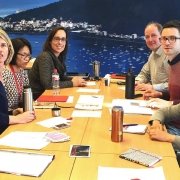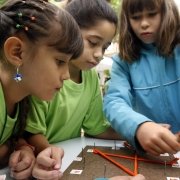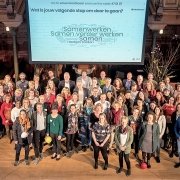Platform Urban Education 070
Excerpt
Excerpt:
Platform Urban education 070 (PUE070) is a platform in The Hague Area (its telephone prefix is ‘070’ and, therefore, the region is sometimes indicated as ‘070 area’), created by three local primary and secondary education boards concerning five schools that saw their urban student population change rapidly in the last 5-10 years (sometimes earlier, depending on the particular school context). The platform wants to increase awareness among the school employees that the backgrounds of the current students has become highly diverse, that inclusive pedagogy and didactics are needed and that a safe learning environment, in which every student and every teacher feels at home, is essential. The platform PUE070 facilitates (among other things) professionalization, knowledge sharing and mutual workshop visits.
Narrative, origins and objectives of the initiative
What kind of project is this? Please give a short description (summary) of it.
Platform Urban education 070 (UE070) is a platform in The Hague Area, initiated by two local primary and three local secondary schools, five schools belonging to three different boards (Lucas Onderwijs, VO Haaglanden and De Haagse Scholen). These schools saw their urban student population change rapidly in recent years. This development is due to the fact that the population of The Hague (and some neighborhoods of its suburbs), has become ‘superdiverse’ in recent years. This adds to the fact that the city is (more than the other two superdiverse cities in The Netherlands, Amsterdam and Rotterdam) historically highly segregated. An illustration of this fact: about four of the top-ten most prosperous neighborhoods (and suburbs) of the whole country can be found in and around The Hague. Something alike goes for the poorest neighborhoods of the country (only Rotterdam has more of those). Literally, the distance between the wealthiest and poorest of the city is only a few kilometers (oftentimes even less), but these neighborhoods are completely different worlds.
PUE070 platform wants to increase awareness among the school employees about the different backgrounds of the current students, that inclusive pedagogy and didactics are needed and that a safe learning environment, in which every student and every teacher feels at home and can share their personal stories, is essential. PUE070 facilitates (among other things) professionalization, knowledge sharing and mutual workshop visits.
Please tell us why, in general, this project is considered a successful one?
The project is well thought-out; the boards, school leaders, and local and national politics support it and has clear milestones, which maximizes the likelihood of being successful. Moreover, prominent researchers on the topic (like El Haddioui and Fukkink; see ‘Theoretical Framework’) are mentoring (phases of) the implementation. As the project is halfway, a bottom-up process is becoming visible: a group of early adopters, teachers who were already aware of the need to make their education more inclusive, have formed a team of ambassadors from the start (in October 2018), at least one per participating school. These ambassadors put the topic on the agenda and help carry out the planned activities.
And why would you consider it a grass-roots initiative?
The initiative was started by one of the participating schools’ headmasters. From there, other schools followed quickly and part of the teachers of each school supported the idea right from the beginning.
What challenges needed to be solved in this project?
The main challenge is: to create a learning environment that gives each student a fair chance of being successful by offering a safe, accessible and transparent learning environment to everyone. This is only possible if each teacher is given the opportunity to excel in his or her own way, being part of an inclusive team and a role model to his or her pupils.
Is this initiative based on any particular theoretical framework? Which one?
The two most important sources of inspiration are the work of Iliass El Hadioui (lecturer and researcher at Erasmus University Rotterdam), and Ruben Fukkink (professor at University of Amsterdam and Amsterdam University of Applied Sciences). Both scientists wrote about urban education in the Netherlands.
El Hadioui (see his [Dutch spoken] Ted Talk from 2017, Equality in a super diverse class: https://www.youtube.com/watch?v=bW3hp9StP-E) approaches miscommunication and conflicts in the classroom as a result of the differences between the cultures at school (1), in the street (urban culture; 2) and at home (3). These cultural aspects are always present in the classroom, and the rules on the one cultural “status ladder” (in terms of ascending/descending) are quite different from the rules on the other, because different norms and values are dominant in each context. The broader the gap between teachers and their students on the three aforementioned aspects on the one hand, and among the students themselves on the other, the more has to be done to make things work in the classroom. Teachers should be facilitated to (1) recognize and address (potential) misunderstandings by becoming aware of the gaps between themselves (being, of course, also a product of their family breeding, education, neighborhood etc) and their students, as well as those among the students, and (2) to develop mindset, sense, knowledge and skills to address and bridge the gaps.
Fukkink wrote an important book about urban education: onderwijs en opvoeding in een stedelijke context (‘education and upbringing in an urban context’). In most urbanized areas in the world, children and adolescents traditionally perform above average compared to the national standard. Some of them (Like The Hague, but also cities like Amsterdam, Vienna, some cities in Germany, Belgium, UK, US, Korea, Israel, Australia, Canada, Brazil, etc.) form an exception to this rule; performance is below average here. These are so-called majority-minority cities. In short, Fukkink states that we should stop seeing this as a problem and take the discussion to another dimension. Make the urban context and identity part of the curriculum. After all, the level of facilities in a metropolis is much higher than elsewhere and there is much to learn from the city.
Related American sources are also used as sources of inspiration and to provide ways to put inclusive education into practice, e.g. the work of Dr. Frank Tuitt (Denver University) on Inclusive Excellence and Dr. Caroll Dweck (Stanford University) on Mindset.
Researchers of Inclusive Education, a Research Group at The Hague University of Applied Sciences (the biggest university in the Hague Area) are involved in the process of teacher professionalization, helping to bridge the gap between theories and models and educational practice.
(Appendix) Is your intervention standing on its own or is it a part of a bigger and more holistic approach?
The initiative is standing on its own, but encompasses several schools and school types. The intention is to learn from this initiative in the region.
Please describe the group(s) intended as beneficiaries of this initiative
Why has this group (have these groups) been chosen?
The initiative does not address one specific target group. The Dutch school system (and society as a whole), however, tends to disadvantage some people (beginning in their childhood), as it favors others, apart from their talents and potentials. This biasedness happens (mostly) unwittingly.
Disadvantaged students are, among other things, mostly boys, children of migration backgrounds, children of color and children of parents of lower socio-economic status.
Could you please tell us something about the relative size of the (of each) target group, within the school/university population, region and/or country?
Detailed information about this hard to obtain. The governmental Centraal Bureau voor de Statistiek (‘Central Bureau for Statistics’; CBS) maps the division of income throughout the country on the basis of postal codes (each neighborhood in the Netherlands has a unique postal code). So-called APC-areas have a higher percentage (80% above average or more) of low-income households, children with a non-western migration background as well as children with one or both parents living on social welfare. Schools that serve children from APC-areas are entitled to extra subsidies because they are expected to make an extra effort for their students.
The PUE070 schools serve APC-areas to an above average extent.
Which social characteristics are taken into account and what is the geographical area covered?
The Hague area is the geographical area covered. Ad said before, The Hague has a superdiverse population and is also the most segregated city in the Netherlands. The main social characteristics taken into account in this project are roughly: being a child of migration background, a child of color, a child of a lower socio-economic status family and/or a (potential) first-generation student (as boys are increasingly less successful in Dutch 21st century education, “gender” could be one of the main characteristics too).
In addition, parental education, occupational status of parents, family wealth, cultural possessions and educational resources are being considered. Those indices are known as ESCS: Economic, Social and Cultural Status. (https://www.unicef-irc.org/publications/pdf/RC14_eng.pdf).
On which level is the project implemented?
The project is implemented at school level. Professionalization of teachers and school organizations to optimize the match between the schools and their student populations, is the main target.
Please describe the political and socio-economic factors that you believe have been important enablers for your initiative
Did the initiative have political support?
The project certainly has political support. The boards and leaders of the participating schools welcome the initiative. Apart from that, the Dutch Ministry of Education, Culture and Science and the municipalities of The Hague and Rijswijk are actively involved (see also the next question).
How did it fit with local, regional or national policies?
See Activity Plan: the initiative is part of the program for equal changes (“Programma Gelijke Kansen”), set up by the Dutch Ministry of Education, Culture and Science. This program supports and stimulates regions to carry out their own agenda on creating equal chances, and see to it that it maintains part of the policies of municipalities, school boards and their partners. (www.gelijke-kansen.nl)
As for the city of The Hague: the municipality aims to reduce inequality and deprivation, and wants to stimulate developments that lead to equal chances in education; this one of the key points of its policy.
Who are the stakeholders supporting the initiative?
The supporting stakeholders are: the boards, the headmasters, teachers, policy makers, partners (ministry, municipality, researchers and others).
Are there particular demographic changes present that are influencing the project?
No, not that they are aware of.
What is the institutional strategy and culture of the (educational) organization?
Each participating organization/school has its own target group, strategy and culture. What binds them is the sense of urgency: a change of culture is necessary to meet the needs of their community, making it more inclusive and professionalize the teachers to become more intercultural aware and sensitive.
To what extent does the initiative have an influence on institutional policy (or potential influence) of the (educational) organization?
Since the project is evaluated and monitored periodically, it is expected to have a substantial (potential) influence on the policy of its participating schools and boards.
(Appendix) Is there public support for your initiative and the issue it addresses?
Inclusion and inclusive education are currently hot topics in some sections of Dutch society and politics, while, in other circles, the theme is highly controversial.
(Appendix) What other factors do you think have been important for the success of this initiative?
Too early to tell.
Please describe the overall initiative design and the methods and tools used to reach the goals
Please describe the specific activities carried out.
An activity plan is part of the project. The key features are for the years to come (plan will be evaluated and updated annually):
1. Preparatory research (2017-2018). El Hadioui from Erasmus University provided the initiators with his conceptual framework about urban education in the Netherlands; he and his research group guided the process of creating awareness and concepts. In this phase, Fukkink and his work were also involved in the process.
2. Kick-off meeting of the project (October 2018): a monumental day for teachers and staff of all participating schools to launch UE070, with representors of municipalities, universities, educational organizations present, with presentations and workshops and Fukkink as key note speaker.
3. Starting the project (2018-2020): six ambassadors, spread over the five schools, are entitled to put inclusive education on the agenda of their schools, with the assignment to create awareness, initiate activities, lead curriculum development and recruit new adopters to adopt the ideas behind inclusive education. These ambassadors will go through an interactive professionalization program “on the job”.
What were the key roles (teacher, student, management team etc.) within the project?
Key roles up to now are school management, project leader, ambassadors, researchers and participating teachers. Of course, the students are also involved; surely, everything in the project is done on their behalf. However, their role (and that of their parents) is still an implicit, indirect one. This may change over time.
What ideas, tools, theories, models, methodology (etc.) have been used to reach the goals?
As described before, the work of El Haddioui and Fukkink is used to inspire teachers and help them rethinking their professional practice. It helps to them create a mutual framework of thought, storytelling and knowledge sharing.
What are the final revenues of the project?
Too early to report about final revenues, since the kick-off of the project took place in October 2018.
Please describe if your project ensured its sustainability
If so, how did you ensure the short-term impact of the project?
By setting clear milestones in the project and monitoring these. And by placing the people and their learning activities at the heart of the project.
And how did you ensure the long-term impact of the project?
By carrying out the Activity Plan and facilitate the ambassadors and teams in their learning process.
Has your project been replicated elsewhere?
The project has not been replicated directly but has inspired other initiatives, regionally and nationally. There are now four Communities Urban Education, supported by the Ministry of Education, Culture and Science, in Rotterdam, The Hague, Amsterdam and Tilburg and in the Hague other schools are starting to cooperate in the same way as this platform does.
Please tell us about the resources used in this initiative
What was the budget for the initiative?
The municipality of The Hague supported the initiative with an initial grant of 50.000 Euros; apart from that, the schools received 225.000 Euros from the Ministry to set up the project (coordination) and start a professionalizing program for teachers. This budget is (also) used to provide the teachers with means (extra time) to professionalize the school leaders don’t make use of the provided budget, they invested time in the project in order to develop their school organizations.
How much did the initiative depend on volunteers?
The project does not make use of volunteers.
How were the costs perceived by the public/the sector/other stakeholders?
No hard information available about this. But the fact that the national and local governments, as well as the three school boards, support the initiative indicates that the public opinion is well-disposed towards this kind of projects.
To what extent did the initiative achieve its objectives?
Please describe the evidence to support the success of your initiative.
The execution phase of this project took off in October 2018; it is too early to answer this question.
Did the intervention lead to any unintended (positive) outcomes?
The mutual understanding between participating schools was, right from the start of the project, much bigger than expected. Despite the differences between the schools (e.g. primary / secondary education, different situations of the schools in terms of their neighborhood, social context, staff, culture and organization), it was easy to communicate.
What indicators (quantitative and qualitative) have you measured to demonstrate success?
These have to be specified yet.
(Appendix) How did you evaluate/monitor this intervention?
Too early to tell yet.




 Robinson Henao
Robinson Henao

 Interkulturelles Mentoring
Interkulturelles Mentoring